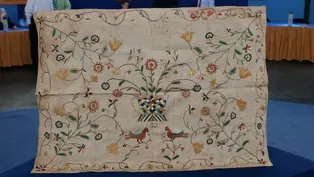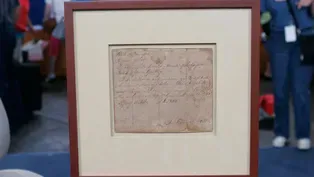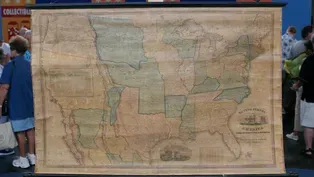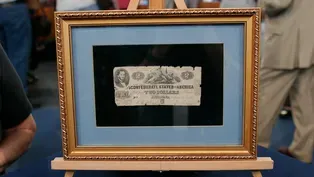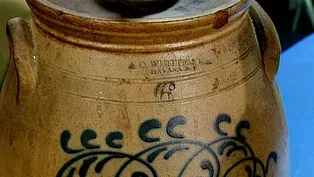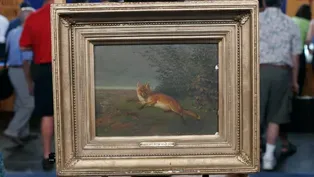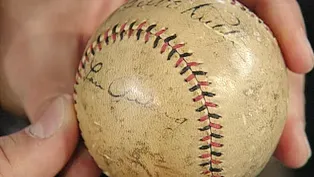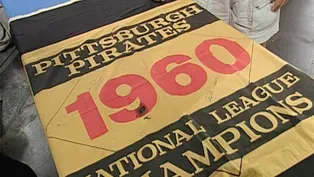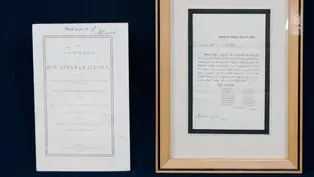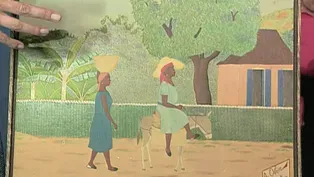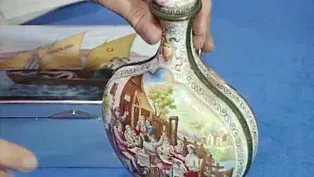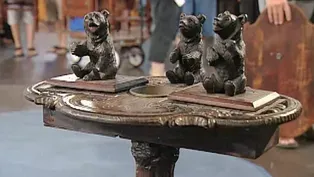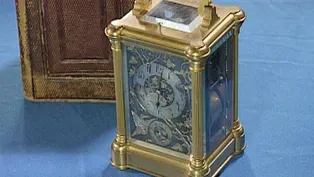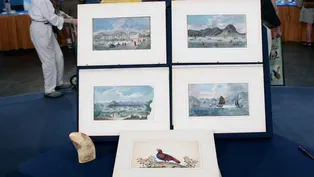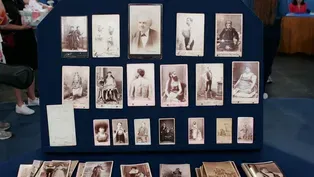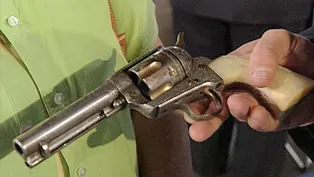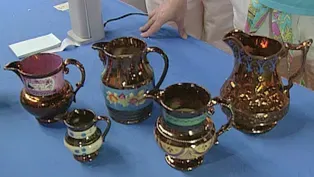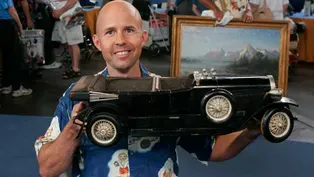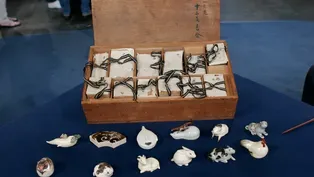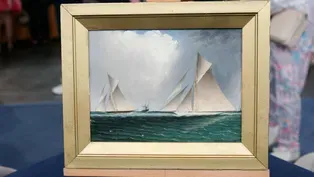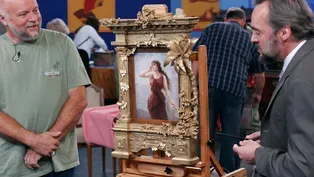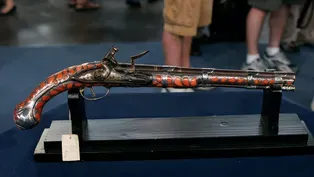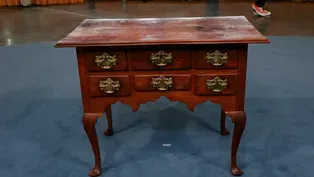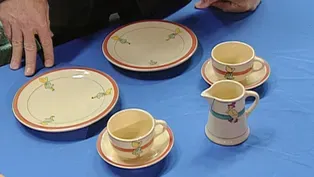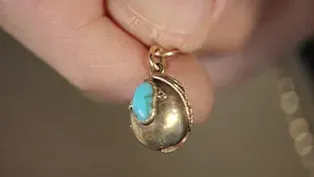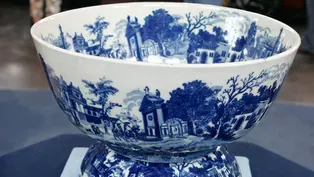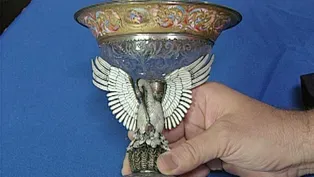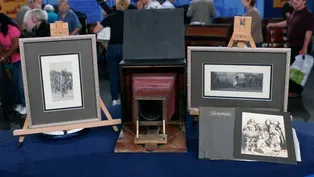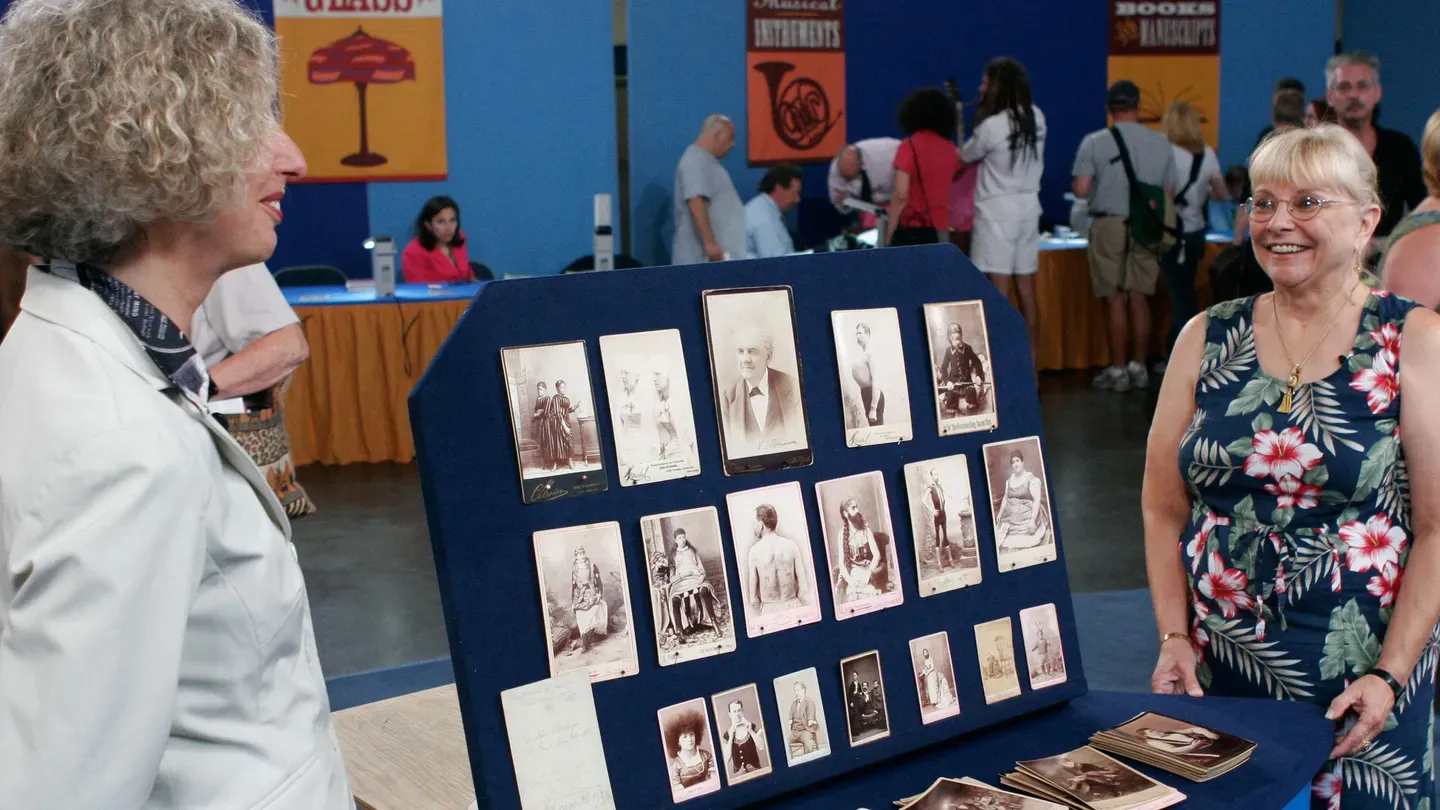

Vintage Tampa 2019
Season 23 Episode 18 | 52m 32sVideo has Closed Captions
Soak up Sunshine State Appraisals from 2005, Including a $100,000-$150,000 Treasure!
Soak up and revisit Sunshine State appraisals from 2005, including a W.S. Starring archive from around 1870, an Isotta Fraschini model car, and an Art Deco star chandelier. Can you guess which is now valued at $100,000-$150,000?
Problems with Closed Captions? Closed Captioning Feedback
Problems with Closed Captions? Closed Captioning Feedback
Funding for ANTIQUES ROADSHOW is provided by Ancestry and American Cruise Lines. Additional funding is provided by public television viewers.

Vintage Tampa 2019
Season 23 Episode 18 | 52m 32sVideo has Closed Captions
Soak up and revisit Sunshine State appraisals from 2005, including a W.S. Starring archive from around 1870, an Isotta Fraschini model car, and an Art Deco star chandelier. Can you guess which is now valued at $100,000-$150,000?
Problems with Closed Captions? Closed Captioning Feedback
How to Watch Antiques Roadshow
Antiques Roadshow is available to stream on pbs.org and the free PBS App, available on iPhone, Apple TV, Android TV, Android smartphones, Amazon Fire TV, Amazon Fire Tablet, Roku, Samsung Smart TV, and Vizio.
Buy Now
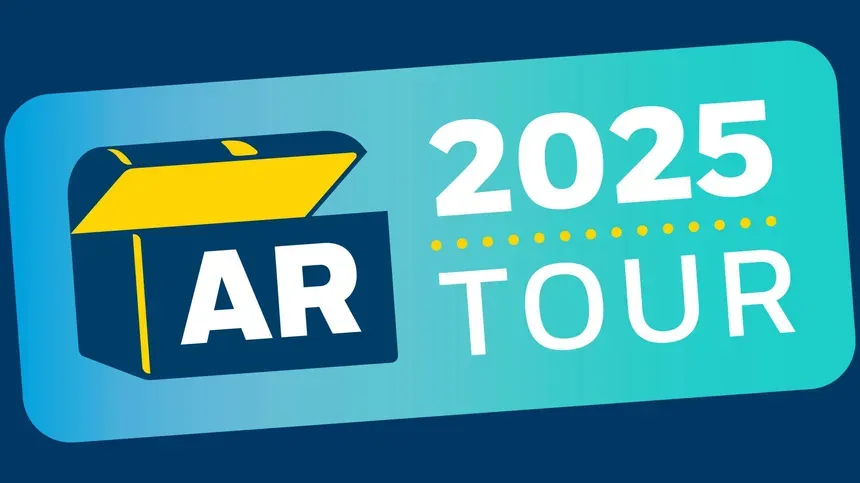
ANTIQUES ROADSHOW 2025 Tour!
Enter now for a chance to win free tickets to ANTIQUES ROADSHOW's 2025 Tour! Plus, see which cities we're headed to!Providing Support for PBS.org
Learn Moreabout PBS online sponsorshipIt's been pure romance to me.
It's pirates, Barbary Coast, Lawrence of Arabia.
It's amazing.
(laughs) I guess I didn't thank her enough for the gift.
Oh, goodness.
She would have a fit.
♪ ♪ MARK WALBERG: In 2005, we visited Cigar City, Tampa, and found some smoking-hot collectibles, including these 19th-century circus photos.
Think you know if the value of these big top treasures went up, down, or stayed the same?
Step right up and take a guess in this hour of "Antiques Roadshow."
Here we are in Tampa, outside of Sarasota, the circus capital of the world.
And you've brought in these marvelous photographs.
The material that we have on display is just a fraction of the photographs that you've collected.
Can you tell me a little bit about them?
Well, I've acquired them over about a 15-year period.
The autographed picture of P.T.
Barnum was my first one.
P.T.
Barnum is, of course, associated with the circus that bears his name.
He was the greatest showman on Earth.
Also referred to as the Shakespeare of Advertising because he really knew how to sell an idea.
We see that the name of the photographer is Eisenmann, and that Eisenmann had a studio in New York.
Eisenmann's studio basically catered to circus performers, outsiders, sometimes known as freaks.
He was the premier 19th-century photographer of theatrical figures.
Some of the performers that appeared in various sideshow circuses: Millie and Christine, Siamese twins; the albino sisters; the snake charmer; this very poignant image of a lady with four legs; the tattoo man; and then the bearded lady, also by Eisenmann.
And you can see that these photographs are the same size.
They're referred to as cabinet card photographs.
They're albumen prints from the 1870s, 1880s, and many of them are signed.
If we turn this photograph over of the Count and Countess Magri, we see that the back of it has their signatures and an inscription.
I also wanted to talk a little bit about these smaller photographs, which are known as cartes de visites-- calling cards.
They were standardized.
And I particularly like Rose d'Alma, who has hair kind of like mine.
And what I discovered in doing some research about ladies in the circus who had this sort of soft and fuzzy hair is, they were known as the Circassian women.
P.T.
Barnum basically introduced these women as special circus figures.
We did a preliminary count, and I believe there are over 110 photographs... Uh-huh.
...spanning some of the circus's most prominent history.
At auction, I would estimate them at $10,000 to $15,000.
(laughs): Wow!
Now I'm shaking.
(laughs) WOMAN: They were cleaning out the courthouse at Dandridge, Tennessee, and they were throwing away everything they thought was unimportant.
This document never happened-- David Crockett didn't marry this woman.
She ran off and eloped with someone else.
We have a little runaway bride situation, huh?
Yes, so they felt that it had no value whatsoever, and therefore it was going to be pitched out.
And my uncle saw it, and being a fan of Crockett, he grabbed it right quick.
Of course.
And it's been in the family ever since.
Ever since-- well, he knew a lot more than they did.
And you can even see where it's been folded up and put in the pocket.
Yep.
It's incredible.
What we have, as you know, is the actual license that was never executed, but it was filled out.
And you can see "From the State of Tennessee," "David Crockett," and his bride-to-be-- her name is a little bit harder to read, but it's right here.
"Margaret Elder, October 1805."
Crockett was 19 years old at the time, so he was a young man.
He was a backwoods statesman, later to become the hero at the Alamo.
I don't think he had done all of those things...
He hadn't done those things.
...at that point.
No, you're absolutely right.
He was just a young guy in love.
Young guy...
He had just learned to read and write the year before.
Yes.
So he was a very late starter.
But boy, did he really make his impression on the world in later life.
It's well documented in the lore of Crockett that he had been about to be married, and that there was a license issued, but it was never executed.
Less than a year later, when he was 20, he did marry then, for the first time.
I think so.
To a woman named Polly Finley.
Mm-hmm.
And they had two children together, and he then moved himself down to Texas and moved up and outward and throughout the world.
But it is an incredible story that such an ephemeral document survives.
It is a real treasure.
We feel that it's worth $20,000 to $30,000.
My goodness, really?
Yes.
That's amazing.
It's irreplaceable and it's...
It is irreplaceable.
And that's an auction estimate.
You know, that's the kind of thing that, two people want it, a historical society wants it... And nobody's going to put it up for auction, either.
For insurance value, that would be at about $45,000 to $50,000.
I see.
APPRAISER: It was made by a wide variety of potters in England from about 1820 to 1850, mostly for the mass market.
They made a tremendous amount of it.
APPRAISER: The Dakota territories were supposed to come in as a single state.
And in 1889, the territories came in as two states.
So flag makers, in anticipation of the Dakota Territory coming in as one, had made these 39-star flags.
Maybe, oh, $1,000 to $1,500.
WOMAN: That's great.
If it were smaller, it would be worth maybe twice that much.
APPRAISER: It's a Russian miniature Easter egg pendant.
This was made at the turn of the century, about 1900, and this is a nice one, made of gold, set with diamonds and set with a turquoise.
MAN: Well, my grandfather caught that in Yankee Stadium, I think in 1927.
Babe Ruth and Lou Gehrig stood on second base and hit a couple of boxes of balls out into the bleachers.
And my grandfather caught one.
They actually signed the balls before they hit it into the stands.
They signed both boxes of balls and then went out to second base and hit them into the stands.
Normally, we don't like to show baseballs that have more than one signature on them, unless they're a team, because it generally devalues the ball.
But that's different in the case of Babe Ruth and Lou Gehrig, the two icons of baseball memorabilia.
And here they are, both on this baseball, which makes it very special.
It's not in the greatest shape in the world, but look at these signatures.
They're, they're bold, and dark, and that's the way they should be.
Yeah.
I know you'll never sell something like this.
No.
It's a family heirloom.
I wouldn't insure it for less than $20,000.
Whoa, my goodness.
It's an amazing piece.
Wow.
WOMAN: I brought in a Confederate two-dollar bill.
It came from my late husband's family.
I teach eighth-grade history, and I use it as a teaching tool.
And I'll bet the kids love that.
They do.
And if you turn it over, there's an inscription on the back.
I try to tell my students that during this war, it wasn't unusual for men of both sides to get together and to talk.
And this is one of those instances.
There's a Confederate soldier who presented this two-dollar bill to my late husband's great-great-great-grandfather, A .W.
Benedict, in 1863.
And it's got his name here, John Graber, I believe it is.
And it was done in a battlefield in Pennsylvania.
If you notice, the 76th New York is the regiment.
Uh-huh.
That's a very famous regiment.
And the date, April 1863, that's two months before this regiment would go into the Battle of Gettysburg.
Oh, wow.
They suffered huge casualties at the Battle of Gettysburg, which, to a collector or to a student trying to stay awake, is going to make a good little... Anecdote.
Right, exactly.
The note itself was issued in 1862 from Richmond, Virginia, which was the capital of the Confederacy.
In the center of the note, we have the image.
Do you know what that image is?
No, I don't.
This image is of the personification of the South striking down Union.
Oh, wow.
They did a lot of those symbolic images on currency of the time.
And do you know who this man is in the upper left-hand corner?
No, and I probably should.
He's Judah P. Benjamin.
Benjamin, right.
He was in the Confederate cabinet, and he's the only man that was of the Jewish faith that was in the cabinet of the Confederacy.
Right.
It has a few tears, a few folds.
Yeah.
And that just happens from regular use.
The note itself is about a $50 note.
Right.
But, with the inscription on the back, the history, the association with the Battle of Gettysburg, it's probably about a $250 piece.
Oh, wow, thank you.
My mother passed away in 2001 and left me a few other things besides this one.
And do you know where she got it?
Somewhere in Atlanta.
Perhaps at a gallery?
She said it was a gallery somewhere in Georgia.
And you were able to read the signature down here?
Correct.
Which is James E. Buttersworth.
He was born in 1817, lived until 1894.
He was born in England and came from a family of painters.
Okay.
So this appears to be a yacht race.
And one very good clue that we have here is this American flag in the distance.
Correct.
Now, these two boats are racing, and this is what you call a spectator or observer boat.
We don't know the names of the ships, but there might be a way to research this with, say, the New York Yacht Club.
And there are these tiny identifying flags here and on this boat.
And what you might be able to determine from further research is whether this is an America's Cup race.
Oh, okay.
And that would be a very good thing.
Another thing that he liked to do was actually go out in the water in a small boat so that he could observe the ships close at hand.
So you often get the kind of perspective that he had of being right on the water.
Buttersworth was a very meticulous painter.
You can see he had quite the eye for detail.
And this is just a lovely, well-painted example of his work.
Do you have any idea how much your mother might have paid for it?
I have no idea.
None.
They had it in their house, it was hanging on the wall.
And I inherited the trailer with the contents, and this was one of the contents.
A couple of pictures about the same size as yours, also yacht races, sold recently at auction.
They each made about $90,000.
Oh, jeez.
So I think you could safely say, at auction, that this would be an estimate of $80,000 to $120,000.
(bleep) You're kidding.
Oh, goodness.
She would have a fit.
It's a terrific picture.
Oh, mercy.
I think it needs a better frame.
Mmm.
It's going to have to have a better place to hang than near the bathroom.
Because that's where it was hanging, near the bathroom.
WOMAN: Well, my father was a gun collector, and bought this gun at a gun show in Ohio, I'd say around 1960.
I was about ten years old, and fell madly in love with it the minute he walked through the door with it.
It's been pure romance to me.
It's pirates, Barbary Coast, Lawrence of Arabia.
I've just always admired it.
And when he passed away, this is the gun that I got out of his collection, and I just love it.
But I'd love to know more about it.
How much did he pay for it?
It's on the tag here-- it's $350.
Well, you're correct in, this is a North African pistol from the 18th century.
And I would say that it's probably the second half of the 18th century.
And the decoration is composed of these red corals within this silver inlay.
Pistols can be mounted with horn, ivory, other precious metals, stones.
And that's actually what defines this pistol as North African, is the fact that they used the... Red coral.
It's the red coral.
Oh, okay.
And it's got a little bit of gold work on the lock, and it also has a little interesting feature right here, where it appears there's Arabic script on the tang of the barrel.
I cannot read Arabic, but I would actually suppose that this is either the maker's name or it's actually a date.
We did notice that on the back here, there were some restorations to the pistol, and it looks like it's been polished.
Looks like the silver... You know, my father did have...
There were five missing pieces, and I remember when he took it to have it restored, had a couple of these replaced.
Yeah, because generally, it's in very nice condition, and those small little inlays probably won't detract from the value.
But cleaning silver detracts from the value.
Oh, does it really?
Yeah.
And it's interesting that the pirate story is actually probably very correct in this... Really?
Really?
...that this is... yeah, sure.
This was probably made for a fairly wealthy North African in the 18th century.
And as you know, in this country at the end of the 18th century, once we gained our independence from Britain, we no longer had a navy to protect us.
So what had happened is, the Barbary Coast pirates trolled the Atlantic Ocean, and in many cases pirated American ships and even took prisoners.
They're very desirable, these coral-mounted pistols.
I estimate that in today's market, this pistol would bring probably about $5,000 to $7,000 in today's collectors' market.
That's good, I can do that.
I can do that-- yeah, I can do that.
(laughs) That's great.
Well, any Hollywood director that wants to borrow it is certainly welcome to.
(chuckles) We went to a gentleman's house to buy some old toys.
And he carried me out in a... a shed he's got, and this was hanging on a nail in the shed.
He didn't want to sell it, so I called him two more times.
He carried it to several antique shops and then called me back and told me what he would take for it.
He said that he got it at the end of the Second World War, but he didn't say where.
You got to tell me how much you paid for it.
$700.
And how long ago was this?
About three years.
Someone pointed out earlier, they said, "You know, the frame is nice, but it's got some damage."
And they were pointing to this area and some of the other areas that look like they're cracked and split.
That's not damage.
That's original to the frame.
The frame is what we call a ruined columns frame.
Oh, okay.
And originally, it would have had all those splits built into it to make it look like ruined columns that have been overgrown.
It's original to the plaque in the center.
The whole thing was probably made about 1885, when this particular style was very popular.
The only thing bad I'd say about it is, part of the frame, and that it's been painted with gold radiator paint or something.
Someone's had a go and sprayed it, and that's unfortunate.
The best part of it is the plaque in the center.
It's a porcelain plaque made in Berlin, in Germany.
And there's a history of porcelain painting in Berlin that goes back a couple of hundred years.
But at this period, they really got it right.
They really knew how to paint figures, and especially beautiful, alluring young women.
And she's got all the right ingredients-- the scale, the quality of the painting, the subject matter-- to make her a very valuable Berlin plaque.
On the back of her, she has the initials KPM.
That tells us it was made in Berlin, and at the Royal Porcelain Works of Germany.
KPM plaques are all valuable, and their value depends on the subject matter and the scale, and the condition and so on.
This is about as good as they get.
Everything's great about the porcelain, and that original frame is really going to add to it.
I think, if you spend the time and the trouble and the money to have the frame restored back to its original condition-- which was probably wood with some gilding on it-- that could be expensive, but it'd be worth it.
In this condition, at auction, it's worth over $10,000.
Oh, Lord!
We think it could bring as much as $12,000 or $14,000.
That's unreal.
I didn't...
I was thinking a lot less.
I would think, with $1,000 worth of restoration costs in the frame, that $1,000 could be well spent and even elevate another couple of thousand.
All right!
APPRAISER: The mark on the back, the RV, is the Roseville Pottery mark.
These date to the late teens, early '20s, and it's called juvenile ware.
These were meant to be used by children exclusively.
One of the reasons I like this set is because the condition is really superlative in these.
APPRAISER: This particular type of clock is called a carriage clock.
And this is a really fancy example, having these fluted columns.
And what really makes it unusual is this really nicely decorated mat in front of the dial.
Made about 1900.
It was actually a French-made clock made for the American market.
APPRAISER: The one on my side is for cigarettes.
And we've got the center as an ashtray.
So it's a cigarette stand, with the surprise of the base, where you have a little secret hiding place for cigars.
My great-great-uncle received this from the White House somehow.
We don't know how he received it.
Which president's administration was this in?
We were told President Coolidge.
Well, he was in the White House from 1923 to 1929, which was the Art Deco period in art history.
And this is a great example of American-made Art Deco glass, of which there really isn't very much.
At that point, most of the art glass makers were still working in the Art Nouveau style.
The Europeans were working in Art Deco, but not the Americans.
But it's good quality.
And I wanted to show how you open one of the points here so that you can change the light bulb.
Yeah.
What happens with administrations is, the next president comes in, he doesn't like the way the decoration looks, and he brings in a new decorator.
And I'm sure that's what happened with this.
Because of its historical significance and because it is an unusual form, I would put $2,500 to $3,500 on this piece.
Okay, well, thank you very much.
Thank you for bringing it.
I grew up around this piece of furniture.
It's been in the family for several generations-- four, that I was told about.
And it was in Fairfield County, Connecticut, in a family homestead.
But I always remembered it and loved it, and it was given to me by my aunt in the '90s.
I believe it's walnut.
You're correct, it's black walnut.
It has a really nice, mellow, old surface.
It's not an original finish, but it has great color, and the walnut has great figuring in it.
On the top and on the drawer fronts, you see that great curly figure in the grain.
And that's solid-- it's not veneer.
Does it look like a Connecticut piece to you?
I saw an appraisal from the '70s that said it was period New England.
Hm.
But I don't really know.
I thought this kind of wood was more prevalent in Pennsylvania, Ohio area.
Well, you're right.
This is a classic Philadelphia dressing table, or low boy, probably made in the 1750s.
Mm-hmm.
So, this is a very early piece.
Oh, wow.
And I've been through it top to bottom, and it's in really pristine condition.
It has the original pegs that hold the top on.
If you look at the front, these big, beautiful brasses are original.
Oh, wow.
And those were expensive in the period.
So, to have six of them like that is a real expensive detail.
Now, this skirt is particularly interesting.
In studying the early Philadelphia cabinet shops, there's one shop that seems to be using that exact skirt pattern a lot.
And it has relatives in Irish cabinet making, and we think maybe there was an, an Irish influence going on in this particular cabinet shop.
But we don't know the cabinet maker.
So, when I saw this piece, the first thing I did was go through it, hoping maybe there would be a signature in it.
Unfortunately, no signature, but it's one more piece that we can add to that group that's coming out of mid-century Philadelphia.
Wow.
Now, if you look at the knee carving here, you have fairly shallow shell carving.
That's something you see in this shop, but also in the sort of earlier period in Philadelphia.
Another early detail are the stocking feet, or the triffid feet, as people sometimes call them.
You see this in Philadelphia by the 1730s.
In the '40s, ball-and-claw feet start appearing, but there's a big crossover.
From a collecting standpoint, the best detail about this piece, I think, other than condition and brasses, is the big overhang on the top.
Even in the back!
Even in the back.
That was so it could go flush to a wall over a chair rail.
Oh.
So it would be stable.
Wow.
A lot of these that we see have less overhang on the top.
Hmm.
And the proportions are not quite as pleasing.
I think at a major antique show, it would be priced retail probably at $70,000 or $80,000.
(muttering) Come on!
So, it's, it's a great rarity, and it's, it's a real, it's a real treasure.
So, so congratulations.
(blows out sharply) (laughs) Is that a, is that a surprise?
Well, I guess I didn't thank her enough for the gift.
Yeah, it was...
Seven...
It's, it's...
It's quite a gift.
That's amazing!
MAN: I don't know a lot about it.
I picked it up at an estate sale.
The man collected the most unusual items.
He had recently died, his wife had a great story.
She said that her husband told her that when he purchased it, he was told that it had been used as a movie prop, supposedly on a Chaplin film.
So, your feeling is it was a miniature used in a motion picture, and possibly "The Great Dictator."
That's what they thought.
Like, for a long-distance scene where this would be seen driving across the horizon.
It really is an absolutely stunning model and amazingly detailed.
I could just barely make out on the grill here "Isotta Fraschini," which is a classic Italian car, which was really the Rolls Royce of Italy.
Wow.
Now, as to whether or not it was used in a movie, I really think it's the case.
When you see movies from the '30s and '40s, sometimes you'll see those shots where, all of a sudden, this truck is on a mountain road.
Sure.
And you know it's a prop.
Right.
It has the level of detail that would work in that kind of a long shot.
In that shot.
The giveaway is right here in this little metal hook.
They would have created a landscape for it to travel in, and probably have a chain drive that would drag it up the road.
Now, was it in "The Great Dictator"?
I think it just well might have been, because, you know, "The Great Dictator" was a satire, a take-off on Hitler.
Right.
And even though this is an Italian car, it bears a very close resemblance to one of the big Mercedes cars that Hitler favored.
All you'd need to do is buy a DVD of "The Great Dictator," look at it very, very closely.
Very carefully, right.
So you paid $300.
Paid $300 for it, yes.
Just as a model of a classic, classic car, I think it would be easily worth $1,500 to $1,800.
Well, that's great!
So, now, if we could establish that this was actually a prop from a movie as great as "The Great Dictator," and a Chaplin film to boot, I think you're more in the $5,000 to $6,000 range.
Wow!
I need to watch the movie, then, don't I?
You need to look at that movie.
WOMAN: Well, my husband's great-grandfather was the governor of Ohio between 1846 and 1848.
His son was his secretary, who was only 21 years old at the time, and he collected a number of autographs.
Specifically started with the signers of the Treaty of Ghent in 1814.
And he had quite a collection of those.
I don't think the family ever threw anything away.
Well, we've singled out a few particular ones.
The first document is black-bordered, and it's an invitation to Abraham Lincoln's funeral services in Springfield... That's right.
...in April 1865.
These are quite rare.
I've only seen one or two of these ever, because I don't think too many people got them.
You also have the original envelope it was mailed in, which is nice.
Helps document the piece.
And clearly Lincoln and your ancestor had a connection that went way back.
The thing that I really was thrilled to see is this fragile little pamphlet here, which is the text of Lincoln's Cooper Union address.
The title is "The Address of Honorable Abraham Lincoln."
It was delivered in New York in February 1860, so right before the presidential campaign developed.
That's right.
And this happens to be the speech that sort of propelled Lincoln into the national consciousness, made him a national contender for the presidency.
So it's a very important address.
This is how it first appeared before the public, in this pamphlet.
And best of all, up at the top here is this little ink inscription, "With respects of A.
Lincoln."
So, this was presented by Lincoln to your ancestor.
The invitation to the funeral, I would value this for insurance purposes at $2,000.
Mm-hmm.
I'm really quite bowled over by this one.
I looked in auction records.
I was not able to track down another copy with an inscription like that.
And I think if I was doing an insurance appraisal for you on this one item alone, I'd put a value of $60,000.
Wow!
It's a very important piece.
Oh, I had no idea.
It's in wonderful condition.
You've kept it in immaculate condition.
And the inscription is clear, bold.
You couldn't ask for more.
I'm really flabbergasted, because I've always thought that the... the invitation was the real special one.
But without that inscription and signature, this would only be a couple of hundred dollars.
APPRAISER: It's one of the prime period Haitian artists, Antoine Obin, signed lower right.
And this is the classic period of the best fresh Haitian art.
I'd say, you know, maybe between $2,000 and $4,000.
That's good.
That's good.
Good.
I like that-- I like that.
APPRAISER: For years, it was a form that stoneware collectors weren't necessarily that interested in, except when you see a piece of stoneware that's decorated so extravagantly as this, it makes a real difference.
This cobalt, free-form decoration, I think, is especially good.
APPRAISER: It's Austrian.
It's signed by a Viennese artist, and it's dated 1907.
You look inside, it's a cigar box.
Well, this actually is Austrian, as well.
It's silver gilt and enamel.
It's done around 1900.
MAN: This was my father's.
He dabbled in antiques, and I got it from him.
I think it's a salesman's sample.
I did a little bit of research on the internet, and the only thing I came up with was, a funeral museum in Texas said this was made by a company in Oklahoma.
We've had it for a while and never did anything with it.
It was just stored in the attic.
And then, when we sent for tickets for the Roadshow, we got the tickets, and I said, "Oh, I definitely want to take this."
Tried to open it, and I could not open it.
So I took it to my physician.
I had him X-ray it, because I didn't want there to be an occupant.
Okay, okay, good.
Well, I think you have the original sealing element around the rim here, and that probably stuck the top.
So, you eventually pried it open.
Right, mm-hmm.
But the thing about it is, the condition is wonderful.
Now, it's sort of a little gruesome, this kind of collecting area, and I think $3,000 to $5,000 would be an easy sell.
It might not fly off the shelf that first day, but it's a wonderful step back in time.
My great-grandfather shipped on the Portsmouth, which was the second ship into Japan in 1856.
Okay.
He served 38 years in the Navy.
And he was in Asia and the China trade, basically.
All over.
What we've got here is an excellent history of the China trade to the West.
And one of the very first groups, Europeans, that were there as traders, were the Dutch.
And you'll notice that on the hilltops, there are these little black dots and these walls.
Those are actually fortifications.
They were put in by the Dutch.
And this is the Pearl River, outside Canton.
And certainly in the 17th century, it started to expand, and the Dutch put fortifications in there to maintain their monopoly over the China trade.
Well, it didn't work.
So by the time your great-great-great-grandfather was there, these forts were abandoned.
And they were called the Dutch Folly forts.
Huh.
So ships, as they went up the Pearl River, would come through here.
And then they would go to this area, which is called Whampoa Reach.
And you can see, actually, there's an American flag on this ship right there.
Mm-hmm.
And Americans were very involved in the China trade.
Well, the Pearl River was too shallow.
So what they'd do is, they would unload these ships full of cargo and put it on shallow-draft vessels that would go all the way up to Canton.
He was also in other cities.
And if you look over at this picture, you'll see this waterfront with the houses.
That's the city of Macau, which was a Portuguese colony.
Yes.
Because with the Dutch, the Portuguese were among the first traders in Asia, and they again lost their monopoly.
But they maintained it in Macau from the 16th century all the way to the, almost the present day.
They just relinquished it fairly recently.
Mm-hmm.
And you notice that those buildings there are all European-based architecture.
Yes.
Finally, here we come to this city.
This is Hong Kong.
And if you look here in the background, you'll see that there's a little teeny American flag on the hill.
Americans were trading in Hong Kong, even though it was an English colony.
Yeah.
These are probably from the mid-1840s to mid-1850s.
This was all in a big book, along with other pictures that were more typical, like this.
I picked these four out of the 40-something you had because these are much better quality than the others.
The condition's a little rough.
You can see some pieces that have fallen apart.
But you've also got a scrimshaw.
What do you know about it?
My great-grandfather, his stepfather was a ship chandler up in Massachusetts, in New Bedford.
He supplied a good portion of the whaling ships that went out of that area.
And that's where they must have picked this up.
So it's the same fellow that brought all this back... Yeah.
...was the one that brought the scrimshaw.
Right.
I think, at auction, the whole group would bring between $12,000 and $18,000.
Jeez!
(laughs) It's amazing.
WOMAN: I brought a collection of photographs that were taken by my great-grandfather, whose name was Arthur Ludwig Princehorn.
And he was a professional photographer, and he took these in 1901 at Glen Island, New York.
There was a resort there, and during the summer, they had a group of Indians there for, like, a traveling show.
I believe Sioux Indians from the Rosebud Reservation in South Dakota.
And my grandfather took numerous photographs of them over the course of the summer, and we have a few hundred of those left.
And then I... A few hundred?
Yes.
Okay.
And we found a few of them framed, but most of them are just still loose.
And I also brought a camera that my great-grandfather actually built so that he would have a more satisfactory camera for taking the pictures.
So we believe that it's actually the camera that took many of the pictures that we have today.
The family history is that my great-grandfather at one point showed the camera to the curator at the National History Museum, and that curator made a copy of the camera, and that copy was supposedly used to design the modern Graflex.
It's not in very good shape.
Okay.
It's missing the lens and the shutter.
Yes.
But if indeed the camera is a prototype for a Graflex, you're talking $600 to $800.
Okay.
But the value of all this is, it's an archive.
In the late 1800s, the Indian wars had pretty much ended.
All the fights were over.
And there was a huge interest worldwide in what had happened in the American West.
And a man, Buffalo Bill Cody, came along.
Yeah.
Buffalo Bill tried a Wild West show in the 1870s, and they tried again in the 1880s.
It was a tremendous success clear through the '90s.
By 1900, everybody who had shows was trying some little Wild West show, with horses and riders.
All of a sudden, the world was changing, and there was a lot of nostalgia, and your great-grandfather was there with his camera.
Yeah.
These are Sioux Indians.
It is Rosebud, but they're Brulé Sioux.
Okay.
And the Brulé Sioux in the 1870s were in Nebraska.
Okay.
There are some other bands of Sioux in here.
Okay.
He did photographs like this, standard portraiture.
This one's great, because it's a group shot.
Right.
And it's Hollow Horn Bear in the middle, who's a very important Sioux chief in the 19th century.
Okay.
There are other photographs that, in my estimation, are probably more important because they document the show and they're action photographs.
Right.
This one here, which shows them on horseback.
One man's firing off a rifle.
Yeah.
It looks like a Winchester.
The other one shows a dancer, and the dancer looks like he's having a great time.
These guys were paid to come do this.
It was a warrior society.
Mm-hmm.
And it was a way for them to re-enact the past.
The portrait shots are not that unusual, but these are beautifully done.
There's 31 photos in here.
11 of them are large portraits, and the other 20 are small action shots.
Okay.
These individual photographs are signed, which helps.
Yes, I think these are the only four that were signed, is the ones they framed.
Oh, really?
It needs to be kept together as a group.
Yeah.
You're not going to get rid of these things.
No, never.
This is so irreplaceable-- that probably kicks it up to $18,000 to $20,000 for insurance.
My goodness gracious.
My grandfather would have been thrilled.
I got this map at an auction that was operated by the Vermont Historical Society.
It was an auction in which people donated things, and this appeared.
You were telling me you were a graduate student in history?
Right.
And what did you do after you graduated?
I got my Ph.D. in history, and I expected to go off into college teaching or things of that sort.
But I received an offer I couldn't refuse from C.I.A.
And so I ended up in intelligence operational work here and there around the world.
We've had a number of clients who have been historians who ended up in the C.I.A.
Oh, is that right?
Who were, and they all like maps.
Yeah, well, if you travel the world, you don't want to get lost, you know.
(laughs) It's a map of the United States.
And it was done in Hartford in 1848.
By 1800, the eastern part of the United States was fairly well similar to what it is now.
But the West was just opening up.
You had the Louisiana Purchase at the beginning of the 19th century, and then they set up some territories out west-- the Missouri Territory, which covered really almost all the area of the Louisiana Purchase.
But as things developed and people moved out there, they started breaking up that big territory into smaller units.
And as you can see, you have the Missouri Territory up here, and it's quite small.
One of the important territories was this green one down here, which is the Indian Territory.
And that was a time after 1800 when they started moving the tribes from the East, and they moved them west.
And you can see, it's really a very large territory.
And along here are the names of the different tribes.
Many of them are Eastern.
Here's the Senecas.
Down here, you have the Creeks and the Choctaws, and that was where they were settled by the U.S. government.
Now, of course, the Indian Territory kept shrinking, so it ended up being very small, and became Oklahoma Territory.
But at this time, it was quite large.
Another interesting thing about this map is Texas, because Texas became an American state in 1845, just three years before this.
That precipitated the Mexican-American War.
This map does not show the results of that.
It does show Texas as a state.
But in 1848, the year this map was issued, the United States actually gained all the territory up here, which at this time is shown as part of Mexico.
They couldn't quite keep up with the change.
And you can see down here, it says, "Part of Mexico," and it actually goes into Texas.
So this shows Texas right at the beginning, and interestingly, you see this very large bit of land up here?
That's what the Texans claimed.
And as the Americans were starting to break it up into smaller bits and add the other territories up here, they actually took back a lot of that land and took some of the Texas debt.
And that was done in 1850, a couple of years after this.
This map is of the United States in that history at that very important time, in our... especially Western history.
That's what gives it the value.
Now, you bought this at auction, how long ago?
15 to 20 years.
Okay, and do you remember what you paid for it?
Yes, slightly over $200.
Okay.
If we had this in our shop, I would probably put about $1,600 on it.
So, which is a pretty good increase over $200.
Yep, right.
(laughing) APPRAISER: It's pure Art Deco design, circa 1920s.
It's considered a cocktail ring.
On the side, you see the little etched work on there.
And then it's showcased with about two carats of diamonds, total weight.
Value on this at auction would be right around $2,000.
WOMAN: Oh, wonderful.
Yes.
Wonderful, great.
Yeah.
APPRAISER: It is a Colt Single Action Army revolver, also known as the Peacemaker.
This gun, from the serial number, appears to be somewhere around the 1880s.
All of these would have been extras.
The engraving, the gold wash, the mother-of-pearl grips.
First of all, it's a silver base.
And then, it has this wonderful enamel decoration on the inside, as well as the outside here.
And that's very carefully painted with enamels and then fired.
Then, the pelican here, it's a pelican feeding its young.
For Viennese enamels, this is like a giant piece, because most of them are small figures.
WOMAN: Yes, okay.
They're really miniatures.
Of course, one of the greatest moments ever-- 1960, game seven, World Series-- where were you?
I was a University of Pittsburgh student outside the ballpark because I couldn't get a ticket to get in.
You heard the Mazeroski shot, bottom of the ninth inning.
Walk-off home run.
Wins the game, wins the World Series.
What happened next?
Well, then everybody could come in the ballpark.
Mm-hmm.
So I came in, looking for a piece of memorabilia.
There were people taking home plate, banners on the side and whatever.
And, you know, there was nothing for me.
And then I looked out into center field, and on the flagpole, there was this flag, okay?
So, young and foolish, I climbed the flagpole, brought this down.
How tall is the flagpole?
About 70 feet.
Would you do that now?
No, never-- never, never, never.
I notice you got it signed, "To Bill Martin from Harvey Haddix."
Right.
Of course, perfect game that ended up not being a perfect game.
Then we have Bob Skinner, we have Bill Virdon.
No Roberto Clemente, unfortunately.
Well, he wasn't... Yeah, yeah, that's true.
Or Mazeroski, which I know you're trying to get.
I've tried to get Mazeroski's autograph.
If I were putting a value on this-- I know in your heart, it's priceless, obviously.
And I know there are other people who would love to have it.
But if it was in one of my sports memorabilia auctions, I'd put an auction estimate of $3,000 to $5,000.
Oh, wow.
But you never know where it just might end up.
Yeah.
WOMAN: It was given to me by my grandmother, who will be 99 in October.
And it was made by my great-great-great-great- grandmother.
We believe, of course, by the date on it that it was made in 1789.
The family history goes that she came over from Holland after coming from England, and the family settled in New York.
Well, I would call this a needlework table cover because of the size.
Mm-hmm.
The first thing that's really great about it, or unique about it, is the fact that it comes from the Dutch tradition of needlework instead of the English tradition.
We see a lot of English tradition needlework here on the Roadshow, and this is the best example of Dutch workmanship I've ever seen.
Wow.
The other thing that I think is very important about it is that if you look at it as an overall object, it really has a lot going for it.
Not only is it large, but it's very well executed.
Amazing detail in this basket, almost like little half-fans, the early date, the birds.
It's such a rare thing.
I bet you I could find you 5,000 samplers, and I couldn't find you more than one or two of these.
My colleagues and I talked about it, and we feel very comfortable with an insurance figure of $40,000.
Whoa.
My grandmother will be very happy, I'm sure, to hear that.
WOMAN: I found it in a shed.
It was covered with filth.
I just kind of cleaned it up a little bit, and it's been hanging in my bedroom.
And when we got tickets for the show, I was trying to think of what to bring.
And I thought, "Well, I'll take that plaque and see if I can find out anything about it."
This was made by the Rookwood Pottery.
They worked in many different types of glazes and lines.
And this is called a scenic vellum plaque.
It has a snowy dusk landscape, which is very desirable.
The artist has signed right here; her name was Sally Coyne.
And Sally Coyne was with them from the 1890s all the way until 1936, a few years before she died.
This is mounted in its original Arts and Crafts frame.
That is the Rookwood Pottery mark, RP.
And when it's filled with these little flames, the dates after 1900 are added in Roman numeral.
So this is 1918.
This is the original price of two dollars.
Wow.
Now, you said you've cleaned some of it.
Did you remove the piece?
No, no.
You can pop these little nails out and soak it in very warm water and a little bit of detergent.
Soak it overnight, and that will get into some of the crazing over here, and that should lighten all of that.
This glaze is very matte, which was arrived at by putting an over-glaze of lots of little bubbles that refract the light.
Would you like to know what it's worth?
(laughing): Yes!
Two dollars.
$4,000 to $5,000.
Oh, my gosh, you're kidding!
(cries softly) (voice breaking): That's amazing.
(laughs) (crying): Good.
I'm glad it's good news.
I think it's good news, right?
It is, it is.
Wow, that's really something.
Two dollars, it sold for, huh?
Wow.
I can't believe that!
Aww.
That's great.
You've brought in a very interesting group of material today, and it comes from your great-great-uncle, right?
That's correct.
There's a photograph taken, I think, towards the end of his career, but he was born in New York, and he moved out to Illinois when he was in his teens, went back east to West Point, where he was a cadet from 1860 to 1865.
Mm-hmm.
After he graduated from West Point, he was with the U.S. Army, and he went out to the Dakotas, Fort Laramie, Fort Kearny, where he studied with the Sioux who were out there.
Well, his work at Fort Laramie is what really interests me.
Fort Laramie was a, a very important post along the Oregon Trail.
It was established as a fur trading post in 1834, and then with the California Gold Rush in the late 1840s, it became a military post.
Your great-great-uncle happens to have been there at a very momentous time in the history of printing in America.
He printed this book, which is called "Lahcotah," and he signed it here on the cover.
It's a dictionary of the Sioux language-- the rules of pronunciation, et cetera.
And if I just turn to the back... We see that the book was printed in Fort Laramie, Dakota, December 1866, and that W.S.
Starring was the co-author of the book with J.K. Hyer, and an Indian interpreter, Charles Guerreu.
Not only is it this printed book, but it's filled with his pencil annotations correcting it, so it makes it a very significant copy of this book, because it's the author's own, and it's with his corrections, very simply bound with these staples.
He also has with it what we call two gorgets, and I've talked to the colleagues on the tribal arts table.
And it would've been worn around the neck on a breastplate, and it carries these decorations.
These happened to be owned by two of the senior-most chiefs of the Sioux Nation in the 1870s, Red Cloud and Spotted Tail.
They tell me conservatively, the value on these would be about $8,000 to $12,000 each.
Each?
Each.
(laughs) But let's go to the book.
This is the first book printed in Wyoming, and collectors of Americana are so passionate about having the first book printed in any of the territories.
Happens to also be about the Sioux language, so it has an extremely important ethnographic interest, as well.
This book at auction, I would estimate at $60,000 to $80,000.
For one book.
For this copy, the author's copy with his annotations... (chuckling): Wow.
...the first book printed in Wyoming.
With the other items, for the whole collection, you're looking at an archive value of roughly $100,000 to $150,000.
(laughs) Wow, that's... Had you any idea that this kind of very humble-looking book would, would be worth so much?
We were trying to guess, and we, we weren't even close.
That, that's, um...
Uh... That's incredible.
Well, it's a highly significant book.
And I don't know if, if because of the annotations make it worth that much more.
Yes.
We have... We have two more copies, they're not... Only one copy has come up at auction in the last 25 years, and it made $30,000, and that was in 1999.
That was for just a standard copy, and it had some condition problems.
This is easily twice is good.
It's an incredibly rare book.
WALBERG: You're watching "Antiques Roadshow: Vintage Tampa 2019."
WALBERG: And now, it's time for the Roadshow Feedback Booth.
This little piggy went to "Antiques Roadshow," and it's an interesting piece.
Don't know a lot about it, but they'd never seen one before, and we're going to do a little bit more research on it, and hopefully we have a treasure.
It makes...
Thank you very much.
It makes cute cornbread.
It makes great cornbread.
Mom said the plate was ugly, but as it is, it's $1,500, or if we get it repaired, it's worth $4,000.
So, pretty good for a yard sale find.
We brought our cowboy boots that we used to play with when we were kids, and we used to fight over them like crazy.
They're not worth much, but they have a nice patina.
And we're still fighting over them.
I've been watching the "Roadshow" since I was little, and I was so happy to come here and get these stuff appraised.
I was in Venice, Italy, at a flea market and I got these for 50 euro, and I come here, and my shoes are worth more than these.
For this little guy here that we bought at a closing on a funeral home, and considered it folk art, and we had a great time, and he's worth $500.
Yay!
I had not one but two reproductions.
I didn't have any reproductions.
I-- I had the bling.
This is my buddy Sam.
We had a great time today.
We're not rich and famous or ready to retire, but we sure enjoyed it.
We found out our-- our heirlooms aren't that much, but at least our son Nathan has a really good time.
And my favorite thing is my ticket stub from the Antiques Roadshow, ten years.
Happy anniversary, "Antiques Roadshow," I love you, bye!
WALBERG: I'm Mark Walberg, thanks for watching.
See you next time on "Antiques Roadshow."
Appraisal: 1789 Dutch-style Needlework
Video has Closed Captions
Clip: S23 Ep18 | 1m 43s | Appraisal: 1789 Dutch-style Needlework (1m 43s)
Appraisal: 1805 David Crockett Unexecuted Marriage License
Video has Closed Captions
Clip: S23 Ep18 | 2m 37s | Appraisal: 1805 David Crockett Unexecuted Marriage License (2m 37s)
Appraisal: 1848 United States Wall Map
Video has Closed Captions
Clip: S23 Ep18 | 3m 26s | Appraisal: 1848 United States Wall Map (3m 26s)
Appraisal: 1862 Inscribed Confederate Currency
Video has Closed Captions
Clip: S23 Ep18 | 2m 26s | Appraisal: 1862 Inscribed Confederate Currency (2m 26s)
Appraisal: 1863 New York Stoneware Butter Churn
Video has Closed Captions
Clip: S23 Ep18 | 24s | Appraisal: 1863 New York Stoneware Butter Churn (24s)
Appraisal: 1874 WIlliam H. Beard Oil Painting
Video has Closed Captions
Clip: S23 Ep18 | 1m 2s | Appraisal: 1874 WIlliam H. Beard Oil Painting (1m 2s)
Appraisal: 1889 39-star American Flag
Video has Closed Captions
Clip: S23 Ep18 | 26s | Appraisal: 1889 39-star American Flag (26s)
Appraisal: 1927 Ruth & Gehrig-signed Baseball
Video has Closed Captions
Clip: S23 Ep18 | 1m 4s | Appraisal: 1927 Ruth & Gehrig-signed Baseball (1m 4s)
Appraisal: 1960 Pirates-signed NL Champions Flag
Video has Closed Captions
Clip: S23 Ep18 | 1m 26s | Appraisal: 1960 Pirates-signed NL Champions Flag (1m 26s)
Appraisal: Abraham Lincoln-inscribed Speech & Funeral Invite
Video has Closed Captions
Clip: S23 Ep18 | 2m 50s | Appraisal: Abraham Lincoln-inscribed Speech & Funeral Invite (2m 50s)
Appraisal: Antoine Obin Painting, ca. 1965
Video has Closed Captions
Clip: S23 Ep18 | 23s | Appraisal: Antoine Obin Painting, ca. 1965. (23s)
Appraisal: Austrian Cigar Box & Enamel Bottle
Video has Closed Captions
Clip: S23 Ep18 | 27s | Appraisal: Austrian Cigar Box & Enamel Bottle (27s)
Appraisal: Black Forest Smoking Stand, ca. 1900
Video has Closed Captions
Clip: S23 Ep18 | 24s | Appraisal: Black Forest Smoking Stand, ca. 1900 (24s)
Appraisal: Carriage Clock & Box, ca. 1900
Video has Closed Captions
Clip: S23 Ep18 | 23s | Appraisal: Carriage Clock & Box, ca. 1900 (23s)
Appraisal: Chinese Paintings & Scrimshaw, ca. 1850
Video has Closed Captions
Clip: S23 Ep18 | 3m 17s | Appraisal: Chinese Paintings & Scrimshaw, ca. 1850 (3m 17s)
Appraisal: Circus Photographs, ca. 1875
Video has Closed Captions
Clip: S23 Ep18 | 3m 4s | Appraisal: Circus Photographs, ca. 1875 (3m 4s)
Appraisal: Colt Single-action Army Revolver, ca. 1880
Video has Closed Captions
Clip: S23 Ep18 | 21s | Appraisal: Colt Single-action Army Revolver, ca. 1880 (21s)
Appraisal: Copper Lusterware Collection, ca. 1840
Video has Closed Captions
Clip: S23 Ep18 | 20s | Appraisal: Copper Lusterware Collection, ca. 1840 (20s)
Appraisal: Diamond Cocktail Ring, ca. 1925
Video has Closed Captions
Clip: S23 Ep18 | 22s | Appraisal: Diamond Cocktail Ring, ca. 1925 (22s)
Appraisal: Isotta Fraschini Model Car, ca. 1940
Video has Closed Captions
Clip: S23 Ep18 | 2m 30s | Appraisal: Isotta Fraschini Model Car, ca. 1940. (2m 30s)
Appraisal: Japanese Zodiac Incense Box Set, ca. 1850
Video has Closed Captions
Clip: S23 Ep18 | 34s | Appraisal: Japanese Zodiac Incense Box Set, ca. 1850 (34s)
Appraisal: J.E. Buttersworth Oil Painting, ca. 1885
Video has Closed Captions
Clip: S23 Ep18 | 2m 25s | Appraisal: J.E. Buttersworth Oil Painting, ca. 1885 (2m 25s)
Appraisal: KPM Plaque in Austrian Frame, ca. 1885
Video has Closed Captions
Clip: S23 Ep18 | 2m 55s | Appraisal: KPM Plaque in Austrian Frame, ca. 1885 (2m 55s)
Appraisal: Miniature Glass Casket Sample, ca. 1925
Video has Closed Captions
Clip: S23 Ep18 | 1m 2s | Appraisal: Miniature Glass Casket Sample, ca. 1925 (1m 2s)
Appraisal: North African Flintlock Pistol, ca. 1775
Video has Closed Captions
Clip: S23 Ep18 | 2m 41s | Appraisal: North African Flintlock Pistol, ca. 1775. (2m 41s)
Appraisal: Philadelphia Dressing Table, ca. 1750
Video has Closed Captions
Clip: S23 Ep18 | 3m 24s | Appraisal: Philadelphia Dressing Table, ca. 1750 (3m 24s)
Appraisal: Roseville Pottery Juvenile Ware, ca. 1920
Video has Closed Captions
Clip: S23 Ep18 | 21s | Appraisal: Roseville Pottery Juvenile Ware, ca. 1920 (21s)
Appraisal: Russian Miniature Easter Egg Pendant, ca. 1895
Video has Closed Captions
Clip: S23 Ep18 | 21s | Appraisal: Russian Miniature Easter Egg Pendant, ca. 1895 (21s)
Appraisal: Staffordshire-style Punch Bowl, ca. 1980
Video has Closed Captions
Clip: S23 Ep18 | 1m 3s | Appraisal: Staffordshire-style Punch Bowl, ca. 1980 (1m 3s)
Appraisal: Viennese Enamel & Rock Crystal Cup
Video has Closed Captions
Clip: S23 Ep18 | 30s | Appraisal: Viennese Enamel & Rock Crystal Cup (30s)
Appraisal: Wild West Show Archive, ca. 1900
Video has Closed Captions
Clip: S23 Ep18 | 3m 41s | Appraisal: Wild West Show Archive, ca. 1900 (3m 41s)
Providing Support for PBS.org
Learn Moreabout PBS online sponsorshipSupport for PBS provided by:
Funding for ANTIQUES ROADSHOW is provided by Ancestry and American Cruise Lines. Additional funding is provided by public television viewers.


